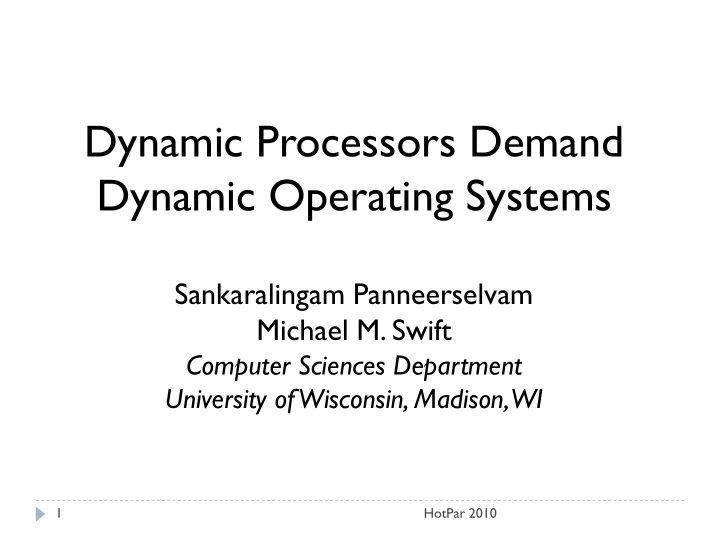

Dynamic Processors Demand Dynamic Operating Systems Sankaralingam Panneerselvam Michael M. Swift Computer Sciences Department University of Wisconsin, Madison, WI 1 HotPar 2010
Motivation Chip Multiprocessor Does not support well for sequential workloads 250 Possible Configurations 200 System with up Speedup symmetric to 256 cores 150 100 50 0 256 128 64 32 16 8 4 2 1 Number of effective cores “ Amdahls law in the multicore era” [IEEE computer, July 2008] 2 HotPar 2010
Motivation Asymmetric Chip Multiprocessor To satisfy diverse workloads 250 200 System with up Speedup asymmetric to 256 cores 150 100 50 0 256 255 253 249 241 225 193 129 1 Number of effective cores “ Amdahls law in the multicore era” [IEEE computer, July 2008] 3 HotPar 2010
Motivation Dynamic Multiprocessor Flexible to cast to the right configuration based on the need 250 200 System with up Speedup Dynamic to 256 cores 150 100 50 0 1 2 4 8 16 32 64 128 256 Number of elementary cores that gets configured dynamically to make a powerful core “ Amdahls law in the multicore era” [IEEE computer, July 2008] 4 HotPar 2010
Examples of Dynamic Multiprocessors Core Fusion Intel Turbo Boost [ISCA’07] [Nehalem] 5 HotPar 2010
Motivation Many mechanisms lead to dynamically variable processors Performance Merging resources: Core Fusion, Speculative Multithreading Shifting power: Turbo Boost, Over-provisioned systems Reliability Redundant execution [ISCA’07] 6 HotPar 2010
Why reconfigure the OS? What happens if a processor goes to offline state without any notification? Servicing of interrupts, IPI, Bottom halves is stopped Other processors might wait for spinlock RCU stall Thread execution is stopped 7 HotPar 2010
Can the OS adapt to changing processors ? Common theme: the number of physical execution contexts may change dynamically and frequently Our work: Analysis of Linux mechanisms for changing processors Two new techniques for dynamically varying processors Processor Proxies Deferred/Parallel Hotplug 8 HotPar 2010
Outline Motivation Current Mechanisms Processor Proxies Deferred/Parallel hotplug 9 HotPar 2010
Why is changing processors hard? Many pieces of code know which processors are available Scheduler Per-CPU structures Distributed operations require processors to communicate Communication between processors - IPI Read Copy Update (RCU) mechanism 10 HotPar 2010
CPU dependence in Linux Analysis of Linux 2.6.31-4 kernel on a 4 CPU machine Number of per-CPU data 446 data structures structures Number of callbacks when CPU 35 callbacks set changes Frequency of global RCU 90 callbacks/second operations Inference: CPU dependences are widespread 11 HotPar 2010
Current solution: Linux Hotplug Hotplug allows dynamic addition/removal of a processor Partitioning/virtualization Physical repair Used for long-term reconfigurations Assumes that processors, once off lined, never comes online Notifies all relevant subsystems, creates/deletes all per-CPU state 12 HotPar 2010
CPU 3 going down 1 3 4 2 Time CPU_DOWN_PREPARE take_cpu_down - disables interrupt - remove cpu from NOP NOP NOP cpu_online_mask loop loop loop CPU_DYING -schedule idle thread on this cpu CPU_DEAD CPU_POST_DEAD 13 HotPar 2010
Hotplug performance Hotplug Cores Latency Operations (msec) 1 25 OFFLINE 2 60 3 137 1 106 ONLINE 2 214 3 331 Good for virtualization but too slow for rapid reconfiguration 14 HotPar 2010
Outline Motivation Current Mechanisms Processor Proxies Deferred/Parallel hotplug 15 HotPar 2010
Our approach Strategy Do very little for short-term changes Do long-term changes off line, asynchronously and in parallel Solutions Processor proxies address short-term reconfiguration Deferred and Parallel hotplug reduces the frequency and latency of long-term reconfiguration 16 HotPar 2010
Processor Proxies A processor proxy is a fill-in for offline processor Provides separate execution context on the proxying CPU called the proxy context Participates in operations that requires the offline processor: Servicing Inter Processor Interrupts (IPI) Ensuring progress in RCU mechanism Does not execute threads 17 HotPar 2010
CPU B CPU A Proxy Native context context Interrupt/Bottom halves servicing B is offline and A is proxying for B Interrupts destined to CPU A Interrupts destined to CPU B 18 HotPar 2010
Processor Proxy Evaluation Result Offline / Online performance compared to native Hotplug Cores Native Proxy Operations (msec) (msec) 1 25 1.7 OFFLINE 2 60 4 3 137 6.5 1 106 1.2 ONLINE 2 214 2.8 3 331 6 19 HotPar 2010
Deferred and Parallel Hotplug Processor proxies are not a long term solution Threads don’t run on a proxy If the reconfiguration is long lasting, move to a stable state Solutions: Deferred hotplug: remove a CPU that is currently proxied Parallel hotplug: reconfigure multiple CPUs simultaneously 20 HotPar 2010
Evaluation Results Hotplug Cores Native Parallel Operations (msec) (msec) 1 25 25 OFFLINE 2 60 60 3 137 130 1 106 106 ONLINE 2 214 111 3 331 131 Performance of CPU online is greatly improved Major time spent in initialization for CPU online Initialization can happen in parallel 21 HotPar 2010
Conclusions Dynamic reconfiguration Operating systems are not prepared Hotplug mechanisms is too slow Low latency solutions Processor Proxies Deferred and Parallel hotplug Future work Resource management 22 HotPar 2010
Recommend
More recommend